
By NIMMI RAGHUNATHAN
LOS ANGELES, CA – The one word that resounded through the Loyola Marymount University campus on the afternoon of Sept.20, was “bridgebuilder.” It was aimed at Dr.Pratapaditya Pal, art scholar and author, who was repeatedly lauded by several speakers for sublimating art from the esoteric to the accessible and bringing...
LOS ANGELES, CA – The one word that resounded through the Loyola Marymount University campus on the afternoon of Sept.20, was “bridgebuilder.” It was aimed at Dr.Pratapaditya Pal, art scholar and author, who was repeatedly lauded by several speakers for sublimating art from the esoteric to the accessible and bringing...
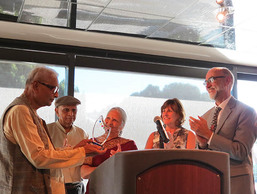
an understanding of the east to the west. As the recipient of the annual Doshi Family Bridgebuilder Award at Loyola Marymount University here, the 80-year-old Pal summed up all the praise, when he got up to collect his award stating, “I can barely stand, my head is so big now.” That levity and bluntness seemed a personality signature, as indicated by the speakers who came up to the dais to share anecdotes on their association with him. The Doshi Award, which comes with a $10,000 stipend, is given annually to honor an individual or organization dedicated to fostering understanding between cultures, peoples and disciplines. The award was established in 2005, along with the Navin and Pratima Doshi Professorship of Indic and Comparative Theology.
The event began with Pratima Doshi speaking about Pal’s work. In her introduction, she pointed out that while the trailblazer in educating the western world on Indian art, as early as 1917 had been the world renowned Ananda Coomaraswamy, it was left to Pal much later, to continue this work, with much success. As senior curator of Indian and Southeast Asian Art at the Los Angeles County Musuem, Doshi recollected, Pal had mounted various exhibitions in the 25 years he was there bringing the art of the region he specialized in, closer to the discerning public here.
Ian Alsop, Editor Asianart.com, whose expertise is in Nepali and Tibetan art, detailed his encounters with Pal, beginning with the books authored by him. When Alsop pulled out two well-thumbed volumes - including one devotedly covered in brocade - which he had bought several decades ago, to make his point on how Pal had been the bridgebuilder for Himalayan art, Pal remarked tartly, “I hope that’s not Chinese brocade,” bringing ripples of laughter in the room.
UC Irvine Professor Gerald James Larson spoke of how Pal with his understanding and writing brought life to objects of art. While doing this, he said, he refused to allow “particularization” of art and instead forced all to see it in a wider perspective with the effect of different cultures evident.
Prof.Alka Patel of UC Irvine also reinforced that point, stating that Pal came with no preconceived notions or political agendas. He was the bridge between the increasing tendency of sub-specialties and the world at large. He was a living monument, she said, asking him if he knew there was a Wikipedia page on him. His reply - no.
Prof.Debashish Banerji from the University of Philosophical Research, Los Angeles, who had worked with Pal on a Rabindranath Tagore exhibit, theorized on the India’s great poet not being an amateur, who overcome by some sudden artistic insight began painting, but was in fact steeped in it from early on.
Pal in his response referred back to Doshi’s talk, pointing out that when he joined the Boston Museum of Fine Art, it was 20 years, after the great Coomaraswamy. “That’s how bad it was,” he said referring to the lack of interest in South Asian art. When he was working toward his doctorate on Nepali art, he said he had been dissuaded by many and instead urged to focus on India, so abysmal was the world’s appreciation of the small nation’s art.
Because he had an understanding of Nepal, Tibet was thrust on him by the art aficionados of the day as they saw little difference and, he said to a laughing audience, “I became an expert,” in Himalayan art. It was a downplaying of his real influence on propelling it to the forefront of the imagination of the art world where Tibetan art commands astronomical prices. Pal said that even the Chinese oligarchs collect it even while ironically, under them, it is getting destroyed. Passionately he pointed out that while the Chinese claim Tibet is theirs, there is not a single Chinese department in any museum in the U.S. that carries Tibetan exhibits. Politics, he said, “eviscerates our cultural life.”
The politics and the complex times during the reign of the Mughal emperor Abkar, in Pal’s mind made him the greatest ruler India has known, greater than even Ashoka. 2015’s bridgebuilder, made his case for Akbar who might be said to be the loftiest of bridgebuilders with this example: the historic Buland Darwaza that stands at Fatehpur Sikri in Agra, bearing an inscription in Persian, the words of Jesus Christ, “The world is a bridge. Pass over it but build no house over it.”
Pal received his award from Christopher Key Chapple the Navin and Pratima Doshi Professor of Indic and Comparative Theology at LMU and the Robbin D.Crabtree, Dean of Liberal Arts at LMU and the Doshis.
The event began with Pratima Doshi speaking about Pal’s work. In her introduction, she pointed out that while the trailblazer in educating the western world on Indian art, as early as 1917 had been the world renowned Ananda Coomaraswamy, it was left to Pal much later, to continue this work, with much success. As senior curator of Indian and Southeast Asian Art at the Los Angeles County Musuem, Doshi recollected, Pal had mounted various exhibitions in the 25 years he was there bringing the art of the region he specialized in, closer to the discerning public here.
Ian Alsop, Editor Asianart.com, whose expertise is in Nepali and Tibetan art, detailed his encounters with Pal, beginning with the books authored by him. When Alsop pulled out two well-thumbed volumes - including one devotedly covered in brocade - which he had bought several decades ago, to make his point on how Pal had been the bridgebuilder for Himalayan art, Pal remarked tartly, “I hope that’s not Chinese brocade,” bringing ripples of laughter in the room.
UC Irvine Professor Gerald James Larson spoke of how Pal with his understanding and writing brought life to objects of art. While doing this, he said, he refused to allow “particularization” of art and instead forced all to see it in a wider perspective with the effect of different cultures evident.
Prof.Alka Patel of UC Irvine also reinforced that point, stating that Pal came with no preconceived notions or political agendas. He was the bridge between the increasing tendency of sub-specialties and the world at large. He was a living monument, she said, asking him if he knew there was a Wikipedia page on him. His reply - no.
Prof.Debashish Banerji from the University of Philosophical Research, Los Angeles, who had worked with Pal on a Rabindranath Tagore exhibit, theorized on the India’s great poet not being an amateur, who overcome by some sudden artistic insight began painting, but was in fact steeped in it from early on.
Pal in his response referred back to Doshi’s talk, pointing out that when he joined the Boston Museum of Fine Art, it was 20 years, after the great Coomaraswamy. “That’s how bad it was,” he said referring to the lack of interest in South Asian art. When he was working toward his doctorate on Nepali art, he said he had been dissuaded by many and instead urged to focus on India, so abysmal was the world’s appreciation of the small nation’s art.
Because he had an understanding of Nepal, Tibet was thrust on him by the art aficionados of the day as they saw little difference and, he said to a laughing audience, “I became an expert,” in Himalayan art. It was a downplaying of his real influence on propelling it to the forefront of the imagination of the art world where Tibetan art commands astronomical prices. Pal said that even the Chinese oligarchs collect it even while ironically, under them, it is getting destroyed. Passionately he pointed out that while the Chinese claim Tibet is theirs, there is not a single Chinese department in any museum in the U.S. that carries Tibetan exhibits. Politics, he said, “eviscerates our cultural life.”
The politics and the complex times during the reign of the Mughal emperor Abkar, in Pal’s mind made him the greatest ruler India has known, greater than even Ashoka. 2015’s bridgebuilder, made his case for Akbar who might be said to be the loftiest of bridgebuilders with this example: the historic Buland Darwaza that stands at Fatehpur Sikri in Agra, bearing an inscription in Persian, the words of Jesus Christ, “The world is a bridge. Pass over it but build no house over it.”
Pal received his award from Christopher Key Chapple the Navin and Pratima Doshi Professor of Indic and Comparative Theology at LMU and the Robbin D.Crabtree, Dean of Liberal Arts at LMU and the Doshis.

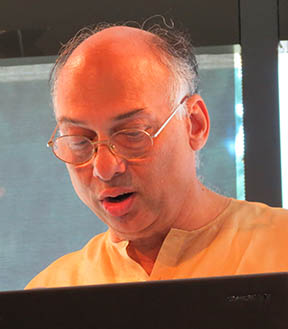
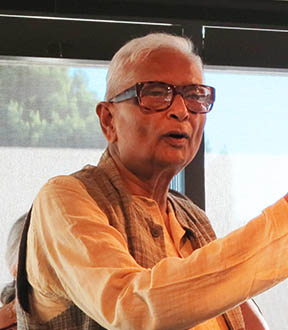
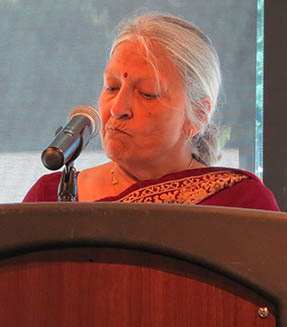
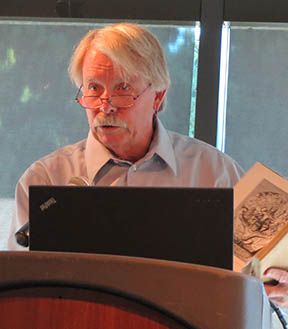
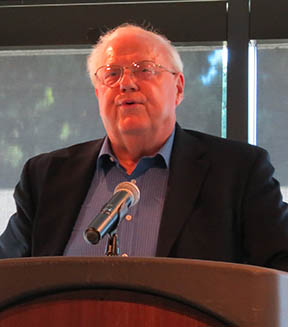
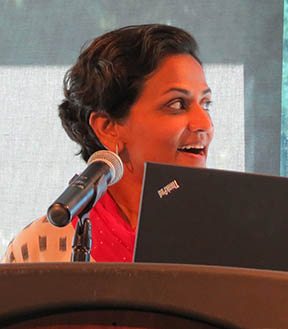
 RSS Feed
RSS Feed
